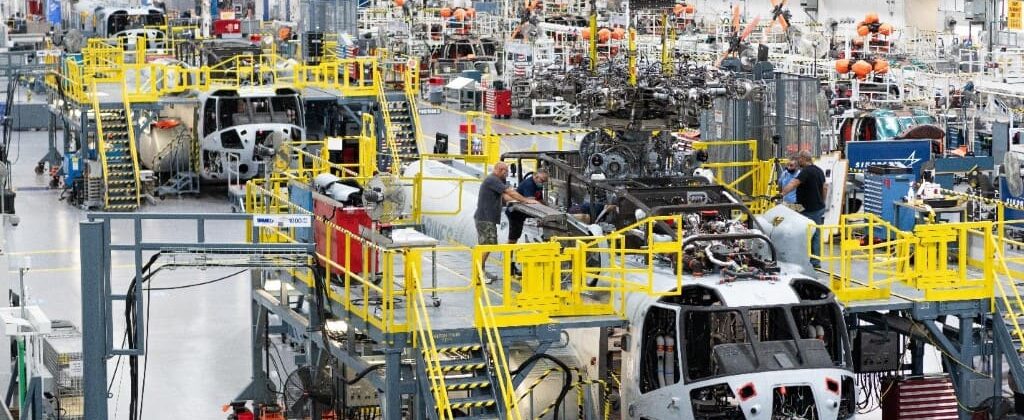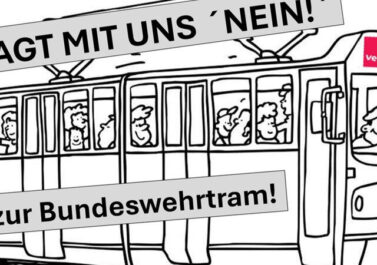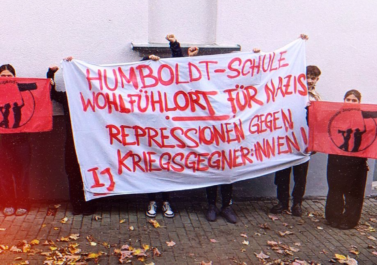
By Oliver Schlaudt and Daniel Burnfin
This text contributes to our discussion about the global drive towards war. It can be read together with recent translations on a new anti-imperialism from comrades in Germany, on the issues of militarisation in France and on the intrinsic link between capitalist accumulation and war from comrades in Italy. The text below questions the benevolence of western military and financial support for the Ukrainian state. In parts it underestimates the productive and trading capacity that the US still has as a major industrial power and overemphasises the ability to control markets through financial and military strategies. We can also question their focus on market saturation as a major reason for the capitalist crisis. Still, a valuable effort to break through the smoke-screen that explains the current global tension by ‘democratic values’.
In view of the West’s horrendous military spending, it is worthwhile to revisit a question that was last posed at the Frankfurt Book Fair in 1987. ‘Is it still a threat or is it threatening again, the “fascist economy”?’ At the time the question was posed by the philosopher Alfred Sohn-Rethel, who was born in 1899 and died in 1990. Sohn-Rethel witnessed the seizure of power in 1933. As a trained economist and Marxist philosopher, he analysed the Second World World War as a reaction to the economic circumstances that had long been apparent. Big industry emerged in the second half of the 19th century, above all the chemical industry and steel production. Their large-scale plants required capital-intensive investments to an unprecedented degree. One direct consequence of this was that companies were less and less able to adjust production to market fluctuations. If they cut back their production when demand fell, the unit costs soared due to the large share of fixed costs as part of total production costs. This exacerbated the sales crisis.
There were three responses by large-scale industry to this dilemma. Firstly, the industry increased pressure on labour costs through Taylorisation and automation. Secondly, there was a tendency to strive for price control by forming monopolies. Thirdly, the industry aimed at fully utilising production capacities through large orders placed by the state. In other words: as production can no longer react to fluctuations in demand on the market, it had to control the market through artificial demand. And the sector in which this artificial demand was most likely to be created was the armaments industry, which promised someone like Adolf Hitler an enormously rapid career. Sohn-Rethel called this phenomenon – armaments as an artificial market – “fascist economics” with a view to National Socialism. But his work ‘Ökonomie und Klassenstruktur des deutschen Faschismus’, published in 1973, is still worth reading today if one wonders how the capitalist economy and the dynamics of war are connected. It offers a basic introduction to the war economy. So what did Sohn-Rethel examine in 1987, around 50 years after the beginning of the Second World War and almost at the end of the Cold War arms race?
The late 1980s was the time when computer technology was being introduced into production and the rigid work routines of assembly line production were softened. There was talk of the “end of mass production” and the “end of the division of labour”. In retrospect, this is also the time when neoliberalism began its triumphal march. Sohn-Rethel remained sceptical about such promises, he was nevertheless cautiously optimistic: new production techniques promised greater flexibility in products and therefore alternative solutions for times of overcapacity. Perhaps there was an alternative to this inner drive, inherent in the relations of production itself, towards a “fascist” economy, i.e. one that would lead to war.
How to recycle dollars
Almost another four decades have now passed. What is the answer today to the question posed by Sohn-Rethel? We again take a more pessimistic view of our present times – for reasons that may be less obvious. It is not simply states such as China, Iran, North Korea or Russia that worry us in this respect. It is also a certain tendency in the western world.
As early as the 1950s, the elite sociologist C. Wright Mills spoke of the “privately incorporated permanent war economy” (PIPWE), i.e. the permanent war economy of private companies. The army general and US President Dwight D. Eisenhower coined the term “military-industrial complex” for an economy that is completely dependent on the state constantly printing fresh money for bombs – and for which an end to the wars would mean immediate collapse. In 1987, the same year as Sohn-Rethel, the historian and diplomat George F. Kennan wrote: “Were the Soviet Union to sink tomorrow under the waters of the ocean, the American military-industrial establishment would have to go on, substantially unchanged, until some other adversary could be invented. Anything else would be an unacceptable shock to the American economy.” Four years later exactly this happened in the form of the Second Gulf War, and in the present days we are experiencing the consequences.
Artificial markets offer a way out of the danger of structural overproduction – and politically, the market for war is close at hand
US-led military interventions have not diminished since the end of the Cold War – and there is still an economic logic behind them, even if this logic has changed. In the run-up to the First World War, the USA provided the European nations with large credits for rearmament and thereby used its economic power in order to extend its political influence as a creditor nation. In 1941, they repeated this in the “Lend-Lease Act”: the government in Washington paid its defense industry for weapons which were then sent to Europe and later had the costs reimbursed by the European states.
However, the Korean War and the Vietnam War tipped the balance. The USA became a debtor in the second half of the 20th century because the US dollar was still tied to gold and the government paid out more money for war funds than it managed to get in return. The 800 military bases that the US military maintains abroad today continue to devour vast sums of money. Astonishingly, however, the USA knew how to turn this supposed weakness into a strength, as economic historian Michael Hudson explains. They decoupled the US dollar from gold in 1971 and – instead of having to first collect the money through taxes – they simply print dollars to cover military expenditure, especially for the purchase of raw materials on foreign markets.
The foreign central banks, in whose accounts the US dollar reserves accumulated, had no choice but to use the money to buy US government bonds. This is because they wanted to avoid that their own currency would increase in value vis-a-vis the US dollar, as this would have hurt their export economy. Thanks to this smart system of “dollar recycling”, the American military expenditure contributed to refinance its own budget deficit and thus increase its own prosperity at the expense of others. The US state managed the paradoxical coup of no longer limiting international supremacy to the position of the creditor, but if necessary include that of the debtor, too. Since then, the USA has played both registers of dollar hegemony: the power of the creditor in the Global South, the power of the debtor in relation to export-oriented industrialised countries.
Who receives the “aid packages”
This brings us to the war in Ukraine, which the public largely sees as a purely moral issue and – less often – as a question of geopolitics. However, a look at the figures shows that the behaviour of the West and its leading states continues to be situated within this economic and political context of power. Washington has granted gigantic “aid packages”, which now total 173 billion dollars, after Congress agreed to the most recent 60 billion package, which had been blocked for a longer period.
But where is this money going? Joe Biden himself has repeatedly explained this to the public, in order to calm critical voices in his own country – for example in October 2023: “We send Ukraine equipment sitting in our stockpiles. And when we use the money allocated by Congress, we use it to replenish our own stores, our own stockpiles with new equipment. Equipment that defends America and is made in America. Patriot missiles for air defense batteries, made in Arizona. Artillery shells manufactured in 12 states across the country, in Pennsylvania, Ohio, Texas, and so much more.”
In February 2024, the President reiterated: “I want to be clear about something, because I know it’s important to the American people: While this bill sends military equipment to Ukraine, it spends the money right here in the United States of America in places like Arizona, where the Patriot missiles are built; and Alabama, where the Javelin missiles are built; and Pennsylvania, Ohio, and Texas, where artillery shells are made.” Remarkably, Joe Biden’s direct political opponent Mitch McConnell, the Republican majority leader in the Senate, gives exactly the same information: ““The security assistance money appropriated ‘for Ukraine’ isn’t just buying weapons for Ukraine. It’s also replenishing and modernizing America’s arsenal. And the vast majority of it is going to American defense manufacturers. This includes funding to expand production lines of munitions needed by the US military as well as vulnerable allies in both Asia and Europe who want to buy American weapons. That’s tens of billions of dollars directly supporting tens of thousands of jobs in at least 38 states so far. Support for Ukraine is driving historic investments in the communities we represent. These are transformational investments. And they wouldn’t have happened without the supplemental funding that we approved last year. We’re not just talking about buying new stocks, but about expanding production capacity to meet U.S. and allied demand. This is a critical piece of our race to compete with China.”
“Workers” and “nation” are smokescreens. Biden is alluding directly to the private companies Raytheon and Lockheed Martin. Also to Boeing and General Dynamics, as well as a few others. Amongst the shareholders of these stock corporations, one group crops up again and again: Blackrock. Last year, Blackrock increased its stake in Raytheon to 6.9%, its stake in Boeing – regardless of the current problems in civil aviation – to 5.4%, that in General Dynamics to 5.7% and that in Lockheed Martin recently to 7.4% and so on. The financial group clearly knows where investments are worthwhile – and its European branch was led by the current German Christ Democratic Union (CDU) leader and possible future German Chancellor Friedrich Merz for five years.
The aid packages are intended to secure Ukraine’s sovereignty politically. But economically, they have the opposite effect
A large part of the American aid to Ukraine is therefore a subsidy for its own defence industry or, in other words, part of a domestic war economy whose function reminds us of Sohn-Rethel’s “fascist economy”. In addition, the American government does not, as one might think, selflessly share or give away part of its resources. It has never collected the money through taxes from its own population and economy, but simply printed it. It is the same scheme as in the two world wars.
Even the formal status of American aid is difficult to determine. Éric Toussaint, historian and expert on international debt relations, considers it to be a subsidy, while the “aid” from the IMF and – significantly – the EU are actual credits. The fact that the American law is called the “Lend-Lease Act”, as it was in 1941, speaks in favour of a mere loan. This would prove Republican Senator Rick Scott right, who emphasises: “90 percent of the funds that we send to Ukraine are granted as loans.” Doesn’t it speak volumes that this question cannot be answered with certainty and that no one seems to be taking a closer look at the legal and economic reality behind the moralised debate?
But whether it is a subsidy or a loan, the result is the same, especially as nobody expects the loans to ever be repaid. It is about something else. The EU and the USA are each trying in their own way to put themselves in a favourable position in order to benefit from Ukraine in the future – both in the protracted war and in the reconstruction which gradually approaches at the horizon. Toussaint summarises the situation as follows: “While Washington and the allied governments, the IMF and the World Bank pretend to be very generous, they are in fact increasing Ukraine’s debt and seek to take advantage of the situation created by the Russian invasion and the ongoing war. It is not the subject of this interview, but it is clear that the Western powers, especially Washington, and the big corporations of the military-industrial complex are pushing for a prolongation of the war. (…) The debt that Ukraine is accumulating already serves and will continue to serve in the future as a means of pressure in the hands of the creditors to make the country pursue its implementation of the anti-popular neoliberal model. The creditors will demand privatizations (of public enterprises, natural resources, arable land and so on) in order to appropriate part of Ukraine’s wealth.”
What Ukraine is paying with
As the Californian Oakland Institute outlines in a report, the appropriation of Ukraine’s globally unique black earth soils is actually already in full swing. This study draws attention to a little-noticed result of the first year of the war: “The total amount of land controlled by oligarchs, corrupt individuals, and large agribusinesses is over nine million hectares – exceeding 28 percent of Ukraine’s arable land. The largest landholders are a mix of Ukrainian oligarchs and foreign interests – mostly European and North American as well as the sovereign fund of Saudi Arabia. Prominent US pension funds, foundations, and university endowments are invested through NCH Capital, a US-based private equity fund.”
President Volodymyr Zelensky had already pushed through the legislative reform necessary for the sale of the land to foreign investors. And the donor countries have already given Ukraine a drastic structural adjustment programme during the course of the war, which aims at austerity policies, privatisation of public assets and their sale to multinational corporations. The creation of a market for agricultural land was only a first step. When the fighting ends, this game of “reconstruction” will continue – and investors like Blackrock will be there.
There is, if we summarise, a really bitter irony here: the “aid packages”, which according to their name are intended to defend Ukrainian sovereignty will in fact have the opposite effect – not on the military-political level, but on the economic one. Russia has attacked the neighbouring country with weapons and occupied its eastern territories. But the West is reaching out for the rest of Ukraine in the shadow of this invasion. And thanks to NATO armaments targets, we are also creating a monopoly market for our arms industry.
So how far do we get here with Alfred Sohn-Rethel’s analysis? The word “fascist” does not fit here in the conventional sense, of course, but this form of economy is dangerous and destructive to this day. It is true that economics does not explain everything. But anyone who pretends as if there were no economy will never understand the world. In view of the increase in prosperity and consumption – on the level of the entire society, regardless of the question of distribution – one might have thought during the past few decades that modern capitalism has solved its structural problems in a “peaceful” way: namely through overconsumption, luxury production and planned obsolescence. We would then only have been at war with nature, which we would have sacrificed on the altar of hyperconsumption.
In reality, however, we can see that – almost 90 years after the outbreak of the Second World War – the artificial market for armaments continues to play a politically relevant role. NATO, which has been constantly expanding since 1989 has maintained a guaranteed monopoly market for the private armaments industry. Our economic system does not only lead war against nature, but continues to fuel the war of human against human. It seems to us that this should be kept in mind when assessing the current situation.
Oliver Schlaudt and Daniel Burnfin teach Philosophy and Political Economy at the Hochschule für Gesellschaftsgestaltung in Koblenz and the University of Chicago



